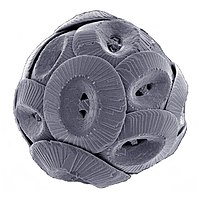
Photo from wikipedia
Microbially induced carbonate precipitation (MICP) is a process that hydrolysis urea by microbial urease to fill the pore spaces of soil with induced calcium carbonate (CaCO3) precipitates, which eventually results… Click to show full abstract
Microbially induced carbonate precipitation (MICP) is a process that hydrolysis urea by microbial urease to fill the pore spaces of soil with induced calcium carbonate (CaCO3) precipitates, which eventually results in improved or solidified soil. This research explored the possibility of using dairy manure pellets (DMP) and palm oil mill effluent (POME) as alternative nutrient sources for Sporosarcina pasteurii cultivation and CaCO3 bioprecipitation. Different concentrations (20–80 g l−1) of DMP and POME were used to propagate the cells of S. pasteurii under laboratory conditions. The measured CaCO3 contents for MICP soil specimens that were treated with bacterial cultures grown in DMP medium (60%, w/v) was 15·30 ± 0·04 g ml−1 and POME medium (40%, v/v) was 15·49 ± 0·05 g ml−1 after 21 days curing. The scanning electron microscopy showed that soil treated with DMP had rhombohedral structure‐like crystals with smooth surfaces, whilst that of POME entailed ring‐like cubical formation with rough surfaces Electron dispersive X‐ray analysis was able to identify a high mass percentage of chemical element compositions (Ca, C and O), whilst spectrum from Fourier‐transform infrared spectroscopy confirmed the vibration peak intensities for CaCO3. Atomic force microscopy further showed clear topographical differences on the crystal surface structures that were formed around the MICP treated soil samples. These nutrient sources (DMP and POME) showed encouraging potential cultivation mediums to address high costs related to bacterial cultivation and biocementation treatment.
Journal Title: Letters in Applied Microbiology
Year Published: 2022
Link to full text (if available)
Share on Social Media: Sign Up to like & get
recommendations!